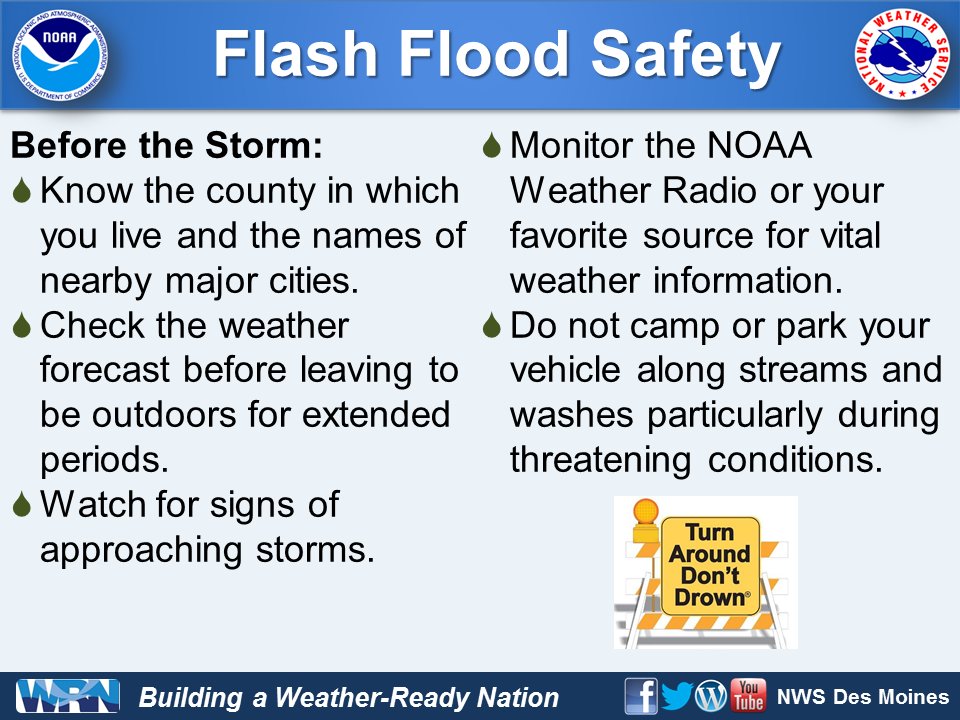Flood Warning: Stay Safe With NWS Flood Safety Tips

Table of Contents
Floods are a dangerous and destructive natural disaster, capable of causing significant property damage and posing a serious threat to life. Understanding flood warnings and following the safety guidelines issued by the National Weather Service (NWS) is crucial for staying safe. This article provides vital information on flood preparedness and response, ensuring you know how to protect yourself and your loved ones during a flood warning. We'll cover everything from understanding different alert levels to recovery after the floodwaters recede.
Understanding Flood Warnings and Watches
What's the difference between a Watch and a Warning?
The terms "flood watch" and "flood warning" are often confused, but understanding the difference is critical for effective preparedness. NWS alerts use these terms to indicate different levels of risk:
-
Flood Watch: A flood watch means that conditions are favorable for flooding to occur. This is a time to monitor the situation closely, prepare your emergency plan, and check your flood risk. Pay close attention to NWS forecasts and local news.
-
Flood Warning: A flood warning means that flooding is occurring or is imminent. This is a time to take immediate action. Follow your emergency plan and evacuate if instructed to do so by local authorities.
Actions to take:
-
During a Watch: Review your family's flood emergency plan, gather emergency supplies, and identify safe evacuation routes. Check your flood risk using resources like FEMA flood maps.
-
During a Warning: Evacuate immediately if instructed. Move to higher ground, avoid floodwaters, and seek shelter in a safe location.
Knowing Your Risk
Understanding your flood risk is the first step in effective flood preparedness. Many online resources can help you assess your risk.
- FEMA Flood Maps: The Federal Emergency Management Agency (FEMA) provides detailed flood maps that show areas prone to flooding. These maps are invaluable for understanding your property's risk. Use the FEMA website to check your address.
Steps to check your flood risk:
- Visit the FEMA website and enter your address.
- Review the flood risk zone designation for your property.
- Understand the level of flood risk – whether it's low, moderate, or high.
- Consider purchasing flood insurance, even if you’re not in a high-risk area.
Preparing for a Flood
Developing a Family Emergency Plan
A well-defined flood emergency plan is essential for ensuring the safety of your family. This plan should cover communication, evacuation routes, and a designated meeting place.
Essential elements of a family emergency plan:
- Communication: Establish a communication plan, including contact numbers for family members, friends, and neighbors. Identify an out-of-area contact person.
- Evacuation Routes: Identify multiple safe evacuation routes from your home, considering various scenarios. Practice these routes with your family.
- Meeting Place: Designate a safe meeting place outside of the flood zone, such as a friend or family member's home.
Building Your Emergency Kit
Preparing a flood emergency kit is crucial for surviving a flood. Your kit should contain essential supplies to sustain your family for several days.
Essential items for a flood emergency kit:
- Water: At least one gallon of water per person per day, for several days.
- Food: Non-perishable food items, such as canned goods, energy bars, and dried fruit.
- Medications: A supply of essential medications for all family members.
- First-aid Kit: A well-stocked first-aid kit with bandages, antiseptic wipes, and pain relievers.
- Flashlights and extra batteries: To provide light during power outages.
- Whistle: To signal for help.
- Important documents: Copies of important documents, such as insurance policies and identification.
Protecting Your Property
Taking steps to protect your property can significantly reduce flood damage.
Measures to protect your home and belongings:
- Elevate valuables: Move valuable items to higher levels of your home.
- Move furniture: Move furniture and appliances away from potential flood zones.
- Use sandbags: Place sandbags around doors and windows to help prevent water entry.
- Install water barriers: Install temporary or permanent water barriers around your property.
During a Flood: Staying Safe
Evacuation Procedures
If a flood warning is issued, follow the instructions of local authorities and evacuate immediately.
Safe evacuation practices:
- Follow official instructions: Obey evacuation orders and instructions given by emergency personnel.
- Know evacuation routes: Be familiar with your designated evacuation routes.
- Seek higher ground: Head to a safe location on higher ground, such as a designated shelter or a friend or family member's home.
Staying Safe During a Flood
If evacuation is not possible, take steps to stay safe in your home.
Staying safe during a flood:
- Move to upper floors: Move to the upper floors of your home if possible.
- Avoid floodwaters: Never attempt to walk, drive, or swim through floodwaters.
- Turn off utilities: Turn off electricity, gas, and water to prevent further damage and hazards.
After the Flood: Recovery and Safety
Returning Home Safely
Returning home after a flood requires caution. Inspect for structural damage and watch out for hazards.
Post-flood safety precautions:
- Check for structural damage: Carefully check your home for any structural damage before entering.
- Avoid downed power lines: Stay away from downed power lines and report them immediately to authorities.
- Cleanup safely: Wear appropriate protective gear when cleaning up flood damage, including gloves, boots, and eye protection.
Dealing with Flood Damage
After the floodwaters recede, assess the damage and take steps to repair it.
Steps to take after flood damage:
- Contact insurance: Contact your insurance company to file a claim.
- Document damages: Document all damages with photos and videos for insurance purposes.
- Seek assistance: Contact relief organizations and local authorities for assistance with cleanup and recovery efforts.
Conclusion
Being prepared for a flood is critical. By understanding flood warnings, developing a comprehensive plan, and taking necessary safety precautions, you significantly reduce the risks associated with this dangerous natural disaster. Remember to always follow the instructions given by the National Weather Service (NWS).
Call to Action: Stay safe this flood season! Learn more about flood safety tips from the NWS and create your flood emergency plan today. Don't wait for a flood warning – prepare now!

Featured Posts
-
 17 Celebrities From Fame To Infamy
May 25, 2025
17 Celebrities From Fame To Infamy
May 25, 2025 -
 Konchita Vurst Togava I Sega Neynata Evolyutsiya
May 25, 2025
Konchita Vurst Togava I Sega Neynata Evolyutsiya
May 25, 2025 -
 Avrupa Borsalarinda Buguenkue Durum Karisik Bir Resim
May 25, 2025
Avrupa Borsalarinda Buguenkue Durum Karisik Bir Resim
May 25, 2025 -
 Trump Suffers Another Loss In Legal Battle Against Elite Firms
May 25, 2025
Trump Suffers Another Loss In Legal Battle Against Elite Firms
May 25, 2025 -
 Doert Oyuncunun Gelecegi Tehlikede Kuluep Skandali
May 25, 2025
Doert Oyuncunun Gelecegi Tehlikede Kuluep Skandali
May 25, 2025
